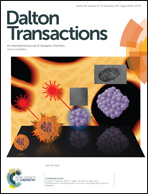Magnetic order in a novel 3D oxalate-based coordination polymer {[Cu(bpy)3][Mn2(C2O4)3]·H2O}n†
Abstract
A heterometallic coordination polymer {[Cu(bpy)3][Mn2(C2O4)3]·H2O}n (1; bpy = 2,2′-bipyridine) was synthesized using a building-block approach and characterized by IR spectroscopy, single-crystal X-ray diffraction, magnetization measurement, and X-band ESR spectroscopy both on a single crystal and a polycrystalline sample. The molecular structure of 1 is made of a three-dimensional (3D) anionic network [Mn2(C2O4)3]n2n− and tris-chelated cations [Cu(bpy)3]2+ occupying the vacancies of the framework. In compound 1 magnetic order is confirmed below 12.8 K – magnetization measurements reveal an antiferromagnetic-like network of canted Mn2+ spins with incorporated paramagnetic Cu2+ centres. The ESR spectroscopy distinctly shows the phase transition; above T ≈ 13 K, single isotropic Lorentzian lines of Mn2+ ions in the high spin state S = 5/2 were observed, while below this temperature, only characteristic Cu2+ signals from cations were detected. Thermal decomposition residues of 1 at different temperatures (800–1000 °C) were analyzed by powder X-ray diffraction; by heating the sample up to 1000 °C the spinel oxide CuMn2O4 [94.1(2) wt%] was formed. From the refined structural parameters, it could be seen that the obtained spinel is characterized by the inversion parameter δ ∼ 0.8, and therefore the structural formula at room temperature can be written as tet[Cu0.17Mn0.83]oct[Mn1.17Cu0.83]O4.
![Graphical abstract: Magnetic order in a novel 3D oxalate-based coordination polymer {[Cu(bpy)3][Mn2(C2O4)3]·H2O}n](/en/Image/Get?imageInfo.ImageType=GA&imageInfo.ImageIdentifier.ManuscriptID=C5DT02933C&imageInfo.ImageIdentifier.Year=2015)

 Please wait while we load your content...
Please wait while we load your content...